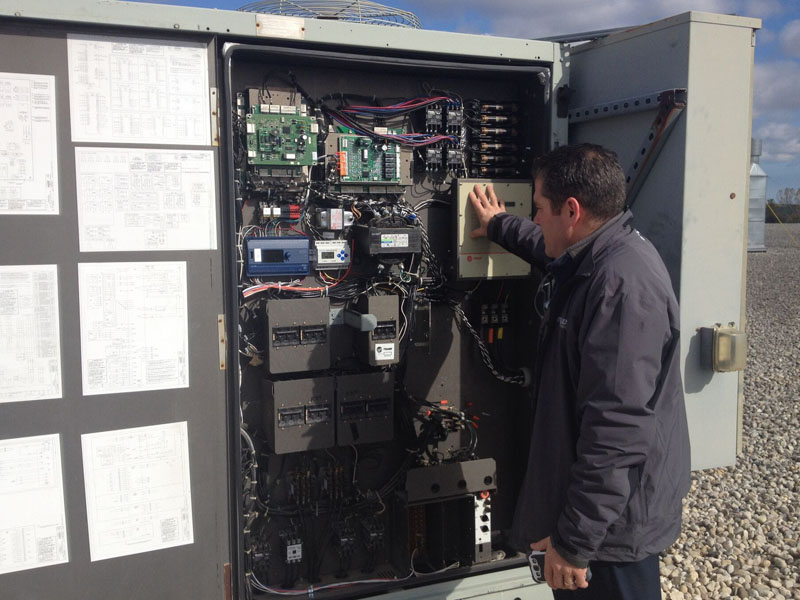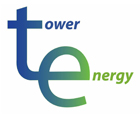EXISTING CONDITION:
This facility tests, develops and manufactures its own motor. Testing involves running motors in 600,000 gallons of water and capturing the exhaust stream for oxidation.
The challenge was to capture the heat off of the oxidizer system and replace exciting MUA units around the plant while maintaining plant comfort and manufacturing temperature tolerance.
HEAT CAPTURED OFF OF REGENERATIVE OXIDIZER TO HEAT PLANT & REPLACE MUA UNITS
All of the heat from this oxidizer was vented to the atmosphere and wasted. A heavy steel heat exchanger was designed to capture the approximately 22,000 scfm flow with minimum static drop. Two fans drive the system with the 40hp fan designed to maintain discharge air temps by varying outside air flow rates. The second fan was designed to balance flow and not affect the oxidizer blower.
EXHAUST MODULATION CONTROL IN PLANT
Three areas of the plant were changed to save energy and take advantage of the new system. Two process areas had VFD’s added to match demand of the fans. This eliminated one MUA system entirely. The third system is on a wash line using 100% inside air to blow off parts. A control package was integrated to blend inside and outside air to maintain temperatures. This cut inside air by 75% on average during the heating season.
RTU ROOFTOPS REPROGRAMMED TO TAKE ADVANTAGE
The 12 RTU’s already had VFD’s and a new BAS system that was programmed to modulate the heating cycle. The new waste heat recovery has eliminated the two main MUA systems entirely. Total consumption of the twelve RTU’s that were conditioning over 400,000 square feet now only cost the company $300 per month to operate. Its primary function is now just mixing air.
THERMS/MONTH BASED ON RECOVERY ALONE
| DATE | 2014 | 2015-16 | SAVINGS / MONTH |
|---|---|---|---|
| 12/1/15 | 55,035 | 34,718 | $ 12,190 |
| 1/1/16 | 63,505 | 35,158 | $ 17,008 |
| 2/1/16 | 81,578 | 62,643 | $ 11,361 |
| 3/3/16 | 78,196 | 51,064 | $ 16,729 |
| 4/2/16 | 74,106 | 41,615 | $ 19,494 |
FIVE MONTH SAVINGS
$76,333
Your Content Goes Here
MUA Control Integration to BAS was Added to Take Advantage of New System
The existing MUA system was not monitored and had no visibility. Adding the unit to the BAS showed that the unit was not modulating and was running during unoccupied times at maximum capacity. The integration immediately spotted the problems that were corrected, and the MUA now modulates to maintain pressure and only runs as needed. The new system was enough to turn the unit off.
CO-INCIDENT KWH SAVINGS FROM RTU 1-12
DUE TO LOWER OPERATION LOADING
| DATE | 2014 | 2015-16 | SAVINGS / MONTH |
|---|---|---|---|
| 12/1/15 | 936,930 | 877,800 | $ 5,950 |
| 1/1/16 | 930,810 | 783,780 | $ 14,796 |
| 2/1/16 | 1,061,910 | 933,060 | $ 12,966 |
| 3/2/16 | 1,016,370 | 950,460 | $ 6,652 |
| 4/2/16 | 1,013,580 | 910,740 | $13,399 |

A new control system with VFD’s and automated logic was added to the twelve main air-handling units to maximize energy savings. This saved over
$ 700,000.00 versus replacement.
Months Payback After Grants
Return on Investment
Five Month Savings*
Combined Five Month Savings
*Calculations take into account the change in cost of power due to lower demand charges even after rate increases.
REAL-TIME MONITORING AND CONTROLS
Real-time monitoring and controls spot problems in the BAS and plant operations based on energy usage and not just performance. Usage spikes that are out of the norm indicate equipment or control malfunctions long before they would show up on the utility bill. Other issues concerning parts failure are spotted in advance, preventing costly maintenance.
CUSTOM CONTROLS
Tower developed a control strategy that didn’t interfere with the existing oxidizer operation and maintained discharge air pressures through the stack. Safety issues were also integrated for fire and low discharge air temperatures to prevent the system from cooling in the event of oxidizer shut down or failure. Additional integration allows visibility through the existing new BAS and provided data for temperatires throughout the plant and heating control of the MUA units. The MUA units were controlled to maintain slightly negative building pressure in the areas served. This allowed the units to fully take advantage of the MUA provided by the new system and modulate down based on building pressure.
TOWER ENERGY MECHANICAL
Licensed mechanical contractors with 30+ years of experience. Licensed master electricians specializing in controls. Practical customized engineering experience to spot opportunities and estimate payback and costs.
